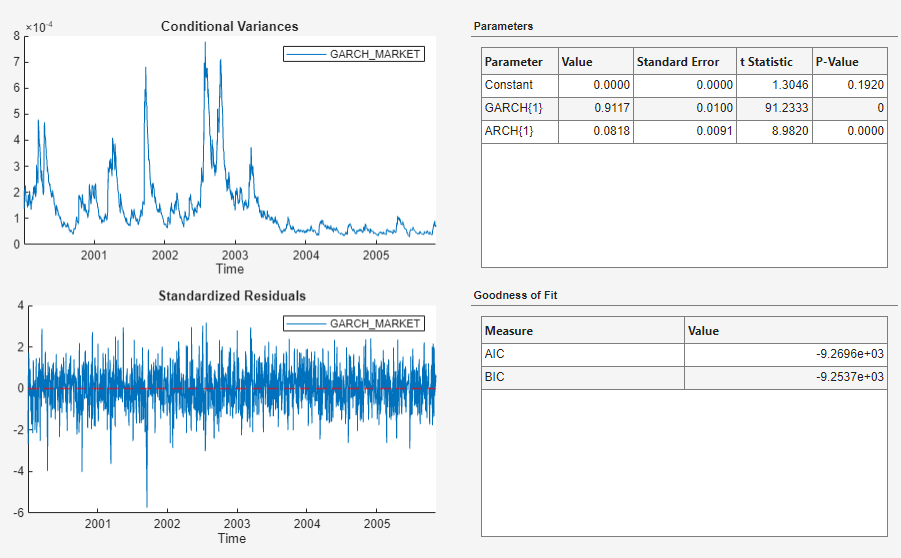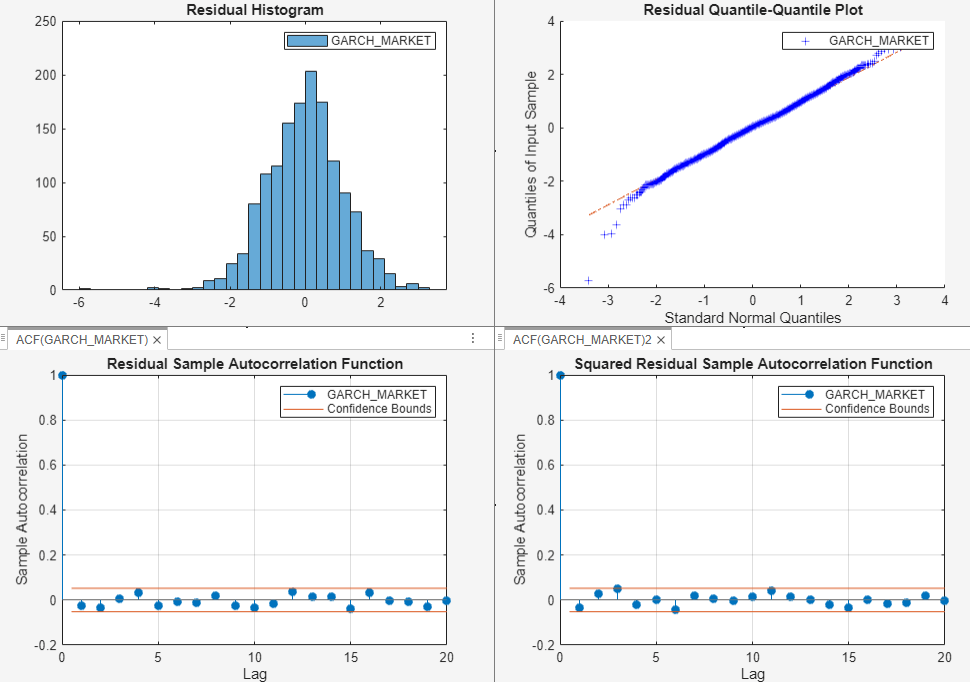Perform GARCH Model Residual Diagnostics Using Econometric Modeler App
This example shows how to evaluate GARCH model assumptions by
performing residual diagnostics using the Econometric Modeler app. The data set,
stored in CAPMuniverse.mat available with the Financial Toolbox™ documentation, contains market data for daily returns of stocks and
cash (money market) from the period January 1, 2000 to November 7, 2005. Consider
modeling the market index returns (MARKET).
Import Data into Econometric Modeler
At the command line, load the CAPMuniverse.mat data
set.
load CAPMuniverseThe series are in the timetable AssetsTimeTable.
At the command line, open the Econometric Modeler app.
econometricModeler
Alternatively, open the app from the apps gallery (see Econometric Modeler).
Import AssetsTimeTable into the app:
On the Econometric Modeler tab, in the Import section, click
 .
.In the Import Data dialog box, in the Import? column, select the check box for the
AssetsTimeTablevariable.Click Import.
The market index variables, including MARKET,
appear in the Time Series pane, and a time series plot
containing all the series appears in the Time Series
Plot(APPL) figure window.
Plot the Series
Plot the market index series by double-clicking the
MARKET time series in the Time
Series pane.

The series appears to fluctuate around y = 0 and exhibits volatility clustering. Consider a GARCH(1,1) model without a mean offset for the series.
Specify and Estimate GARCH Model
Specify a GARCH(1,1) model without a mean offset.
In the Time Series pane, select
MARKET.On the Econometric Modeler tab, in the Models section, click the arrow to display the models gallery.
In the models gallery, in the GARCH Models section, click GARCH.
In the GARCH Model Parameters dialog box, on the Lag Order tab:
Set GARCH Degree to
1.Set ARCH Degree to
1.

Click Estimate.
The model variable GARCH_MARKET appears in the
Models pane, its value appears in the
Preview pane, and its estimation summary appears in the
Model Summary(GARCH_MARKET) document.

The p values of the coefficient estimates are close to zero, which indicates that the estimates are significant. The inferred conditional variances show high volatility through 2003, then small volatility through 2005. The standardized residuals appear to fluctuate around y = 0, and there are several large (in magnitude) residuals.
Check Goodness of Fit
Assess whether the standardized residuals are normally distributed and uncorrelated. Then, assess whether the residual series has lingering conditional heteroscedasticity.
Assess whether the standardized residuals are normally distributed by plotting their histogram and a quantile-quantile plot:
In the Models pane, select
GARCH_MARKET.On the Econometric Modeler tab, in the Diagnostics section, click Residual Diagnostics > Residual Histogram.
In the Diagnostics section, click Residual Diagnostics > Residual Q-Q Plot.
The histogram and quantile-quantile plot appear in the Histogram(GARCH_MARKET) and QQPlot(GARCH_MARKET) figure windows, respectively.
Assess whether the standardized residuals are autocorrelated by plotting their autocorrelation function (ACF).
In the Models pane, select
GARCH_MARKET.On the Econometric Modeler tab, in the Diagnostics section, click Residual Diagnostics > Autocorrelation Function.
The ACF plot appears in the ACF(GARCH_MARKET) figure window.
Assess whether the residual series has lingering conditional heteroscedasticity by plotting the ACF of the squared standardized residuals:
In the Models pane, select
GARCH_MARKET.Click the Econometric Modeler tab. Then, in the Diagnostics section, click Residual Diagnostics > Squared Residual Autocorrelation.
The ACF of the squared standardized residuals appears in the ACF(GARCH_MARKET)2 figure window.
Arrange the histogram, quantile-quantile plot, ACF, and the ACF of the squared standardized residual series so that they occupy the four quadrants of the right pane. On the Documents pane, click the Actions button , select Tile All, place the pointer in the (2,2) position of the matrix of squares.


Although the results show a few large standardized residuals, they appear to be approximately normally distributed. The ACF plots of the standardized and squared standardized residuals do not contain any significant autocorrelations. Therefore, it is reasonable to conclude that the standardized residuals are uncorrelated and homoscedastic.